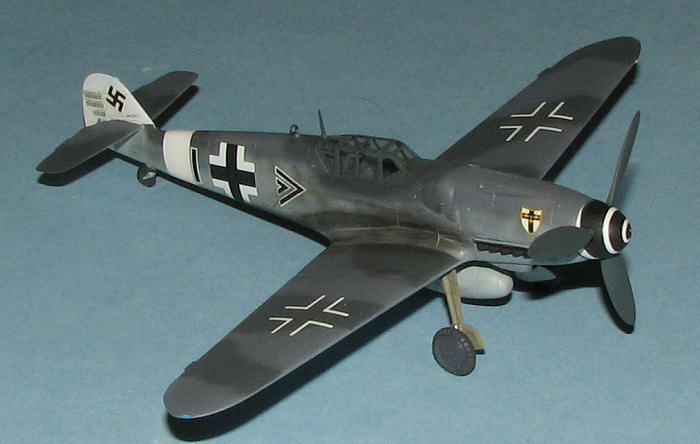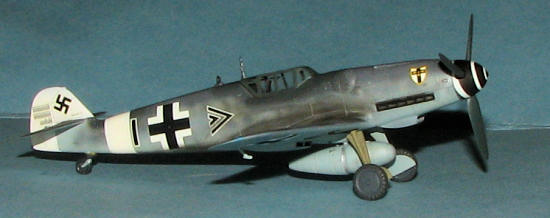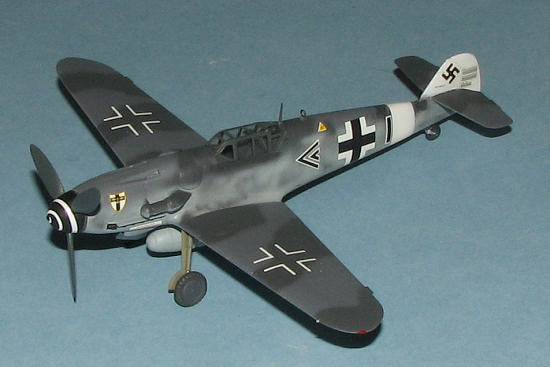
Hasegawa 1/72 Bf-109G-6
| KIT #: | 03014 (SS14) |
| PRICE: | 900 Yen |
| DECALS: | One option |
| REVIEWER: | Scott Van Aken |
| NOTES: | Pre-Painted Canopy |

| HISTORY |
We all know about the Bf-109G-6. Here is something on the pilot of the plane being modeled.
Ernst Düllberg was born on 28 March 1913 at Unna in Westalen. At the outbreak of World War 2, Düllberg was serving in the Stabsstaffel of I./JG 3. On 21 July 1940, he transferred to 8./JG 27. He recorded his first victory, a RAF Blenheim bomber, on 1 August. On 5 August 1940, Düllberg was appointed Staffelkapitän of 5./JG 27. By the end of 1940, he had claimed a further five victories over England during the Battle of Britain. During the brief deployment of II./JG 27 to Russia, Düllberg claimed a Russian SB-3 bomber shot down before the unit was relocated to North Africa.
 On 22
November 1941, Düllberg was wounded in aerial combat with
British fighters but managed to return to his airfield at Ain-el-Gazala
where he made a successful belly landing (Bf 109F-4 trop
W.Nr. 8466). It would appear he was the victim of Australian
ace Alan Rawlinson (8 destroyed, 2 probable and 8 damaged victories) of 3
Sqn RAAF.
On 22
November 1941, Düllberg was wounded in aerial combat with
British fighters but managed to return to his airfield at Ain-el-Gazala
where he made a successful belly landing (Bf 109F-4 trop
W.Nr. 8466). It would appear he was the victim of Australian
ace Alan Rawlinson (8 destroyed, 2 probable and 8 damaged victories) of 3
Sqn RAAF.
In February 1942, Düllberg returned to combat duty serving with 5./JG 27. On 26 May, he was transferred to the Geschwaderstab of JG 27. On 11 October 1942, Düllberg was appointed Gruppenkommandeur of III./JG 27. Düllberg’s total had reached 18 by the end of 1942. By the end of 1943, he had increased his score to 28. In spring 1944, III./JG 27 was relocated to Germany to undertake Reichsverteidigung duties. Düllberg was awarded the Ritterkreuz on 27 July 1944 for 35 victories. On 7 October Major Düllberg was appointed Kommodore of JG 76. He led the unit to Hungary where he led all the fighter units operating in the southeast: II./JG 51, II./JG 52 and III./JG 53 in addition to the Hungarian fighter units. Düllberg claimed his last eight victories, all Russian fighters, during this period. In February 1945, Düllberg underwent conversion to the Me-262 jet fighter with III./EJG 2. In March, he joined II./JG 7, leading ground forces of this unit until the end of the war. Düllberg died on 27 July 1984 at Essen.
Ernst Düllberg was credited with 45 victories in 650 missions. He recorded
nine victories over the Eastern front. Included in his victory total are 10
four-engined heavy bombers.
| THE KIT |
This kit was one of several that were donated to me by a very kind
reader. It was already partially started, so I decided to go ahead and finish
it. This was built along with the recently reviewed Fine Molds 1/72 Bf-109G-6 so
I was able to do painting and such at pretty much the same time, making things
go a bit more smoothly. I have built the 'new mold' Hasegawa 109 a time or two
before  and
when compared to the original molding of the plane, it is quite an improvement.
Designed for the usual 'multiple variants' the kit has separate tail sections,
upper cowlings and the ability to handle a variety of other minor bits that
differentiate between variants. Means that in some kits, you'll have 'extra'
wheels, tail planes, wheel bulges, prop and canopy to name a few parts.
and
when compared to the original molding of the plane, it is quite an improvement.
Designed for the usual 'multiple variants' the kit has separate tail sections,
upper cowlings and the ability to handle a variety of other minor bits that
differentiate between variants. Means that in some kits, you'll have 'extra'
wheels, tail planes, wheel bulges, prop and canopy to name a few parts.
The kit provides a rather basic cockpit with a pretty complete tub to which you add only a control stick and instrument panel. A decal is provided for the instrument faces. There are also optional under wing guns and a drop tank with mount. In this kit, the canopy is pre-painted in RLM 74. This is the biggest attraction as some have quite a bit of difficulty when it comes to masking and painting canopies. For others, it is a bit of a hassle as normally, a masked canopy is painted along with the rest of the airframe, requiring additional care to keep from getting paint on the clear bits. Also can cause differences in paint shades. The canopy is a single piece and not designed to be displayed open.
Typical Hasegawa instructions with Gunze paint references are provided. RLM and generic color information is also given. There are markings for one plane, that of ace Eric Hartmann. These decals are 'old school' Hasegawa, meaning ivory colored white and an aversion to setting solutions.
| CONSTRUCTION |
As mentioned, this kit was built to a level where the fuselage and tail were together as were the wings. I basically needed to continue from that spot. First, I applied filler to the fuselage and wing seams, while removing the lower wing cannon attachment points. I also opened the holes for the drop tank mount. The wings were attached at this point, and I was pleased to be able to get a good fit on the aft wing/fuselage join as it used considerably less filler than I'd feared.
With the wings and fuselage cleaned up, I attached the proper set of tail planes and after cementing together the drop tank, got ready for painting.
| COLORS & MARKINGS |
Seems to come early in this build, but I started by spraying
all the RLM 76 bits. I used Agama's fine line of enamel paints for this and the
previous 109. These are superb paints with fine grain, which makes thinning and
spraying a breeze. Once those were done, I sprayed the inside of the gear doors
with RLM 02 and did the white fuselage band and fin/rudder. You might think it would be
smarter to do the white bits first, but since I generally go back and forth with
colors, it was more like using the RLM 76 as a primer.
and did the white fuselage band and fin/rudder. You might think it would be
smarter to do the white bits first, but since I generally go back and forth with
colors, it was more like using the RLM 76 as a primer.
The cockpit section had been masked and so I then masked the underside of the tail planes and the white parts. Then I used my Skybow AB-100 detail airbrush to paint the upper greys, starting with the lighter of the two shades. Then the darker shade was sprayed on. I free handed the scheme and the result looks very nice indeed. Once that was done, I masked the upper wins and tail plane and then went back with the RLM 76. Then the mottling was done, using the upper surface colors. To cut back on the starkness of it, the side was then misted with RLM 76. Then the airframe was taken back to the bench to have the landing gear attached. Once that was done (at the fit of the main gear is, well, sloppy so take care), I gave the airframe a nice coat or two of clear acrylic gloss in preparation for decals.
The decals for this plane came from SuperScale sheet 72-724, which has been long out of print. It contains a number of Bf-109 Aces planes, and not the usual batch that everyone knows. I chose the G-6 of Hpt. Ernst Düllberg of III./JG 27 when based on Argos, Greece in 1943. The decals were a bit hesitant to come off the backing sheet when I used cold water on them. However, I did get them in place and used Microsol to help them out. One hint for you all is to apply the spinner spiral before attaching the blades. I did not and had to do some cutting.
| FINAL CONSTRUCTION |
 Once the
markings were in place, I added the rest of the bits. This included the gear
doors, the drop tank (the tank mount was missing one of the anti-sway bars), and
the various antenna. The gear doors were glued on as were the wheels. The prop
was attached and I carefully glued on the aileron balances. Finally, the exhaust
and their shields were pushed into place. The fit is so tight that one does not
have to glue them in. I then gave it a coat of clear matte and glued on the
canopy. The last thing done was a bit of pastel work for the exhaust. Sharp eyed
readers will notice that I broke off the pitot tube before I had the chance to
take pictures!
Once the
markings were in place, I added the rest of the bits. This included the gear
doors, the drop tank (the tank mount was missing one of the anti-sway bars), and
the various antenna. The gear doors were glued on as were the wheels. The prop
was attached and I carefully glued on the aileron balances. Finally, the exhaust
and their shields were pushed into place. The fit is so tight that one does not
have to glue them in. I then gave it a coat of clear matte and glued on the
canopy. The last thing done was a bit of pastel work for the exhaust. Sharp eyed
readers will notice that I broke off the pitot tube before I had the chance to
take pictures!
| CONCLUSIONS |
The Hasegawa 1/72 109G is still a very nice kit and unless you have it next to the even nicer Fine Molds version, you don't realize that the Hasegawa's fuselage seems either a bit too long or a bit too thin. The FM kit also has a higher detail level (not surprising from a kit that is 20 years newer) that most may wish to have. However, in terms of price, the Hasegawa kit is less expensive and provides just as much enjoyment during construction as any other.
I will undoubtedly build more of both in the coming years. They are nice kits, fit on the shelf and are just fun to build.
| REFERENCES |
May 2008
If you would like your product reviewed fairly and fairly quickly, please contact the editor or see other details in the Note to Contributors.